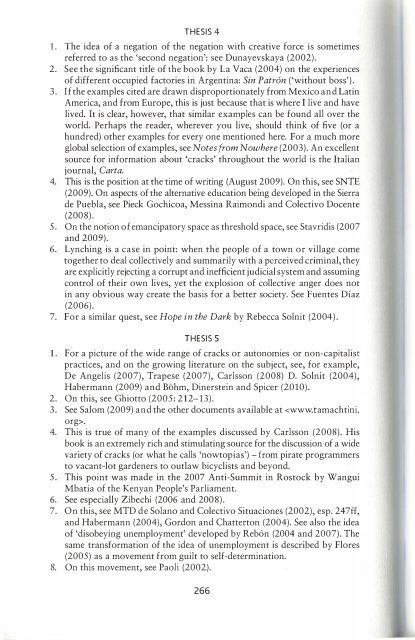Holloway - Crack Capitalism.pdf - Libcom
Holloway - Crack Capitalism.pdf - Libcom
Holloway - Crack Capitalism.pdf - Libcom
Create successful ePaper yourself
Turn your PDF publications into a flip-book with our unique Google optimized e-Paper software.
THESIS 4<br />
1. The idea of a negation of the negation with creative force is sometimes<br />
referred to as the 'second negation': see Dunayevskaya (2002).<br />
2. See the significant title of the book by La Vaca (2004) on the experiences<br />
of different occupied factories in Argentina: Sin Patron ('without boss').<br />
3. If the examples cited are drawn disproportionately from Mexico and Latin<br />
America, and from Europe, this is just because that is where I live and have<br />
lived. It is clear, however, that similar examples can be found all over the<br />
world. Perhaps the reader, wherever you live, should think of five (or a<br />
hundred) other examples for every one mentioned here. For a much more<br />
global selection of examples, see Notes from Nowhere (2003). An excellent<br />
source for information about 'cracks' throughout the world is the Italian<br />
journal, Carta.<br />
4. This is the position at the time of writing (August 2009). On this, see SNTE<br />
(2009). On aspects of the alternative education being developed in the Sierra<br />
de Puebla, see Pieck Gochicoa, Messina Raimondi and Colectivo Docente<br />
(2008).<br />
s. On the notion of emancipatory space as threshold space, see Stavridis (2007<br />
and 2009).<br />
6. Lynching is a case in point: when the people of a town or village come<br />
together to deal collectively and summarily with a perceived criminal, they<br />
are explicitly rejecting a corrupt and inefficient judicial system and assuming<br />
control of their own lives, yet the explosion of collective anger does not<br />
in any obvious way create the basis for a better society. See Fuentes Diaz<br />
(2006).<br />
7. For a similar quest, see Hope in the Dark by Rebecca Solnit (2004).<br />
THESIS 5<br />
1. For a picture of the wide range of cracks or autonomies or non-capitalist<br />
practices, and on the growing literature on the subject, see, for example,<br />
De Angelis (2007), Trapese (2007), Carlsson (2008) D. Solnit (2004),<br />
Habermann (2009) and Bohm, Dinerstein and Spicer (2010).<br />
2. On this, see Ghiotto (2005: 212-13).<br />
3. See Salom (2009) and the other documents available at .<br />
4. This is true of many of the examples discussed by Carlsson (2008). His<br />
book is an extremely rich and stimulating source for the discussion of a wide<br />
variety of cracks (or what he calls 'nowtopias') - from pirate programmers<br />
to vacant-lot gardeners to outlaw bicyclists and beyond.<br />
5. This point was made in the 2007 Anti-Summit in Rostock by Wangui<br />
Mbatia of the Kenyan People's Parliament.<br />
6. See especially Zibechi (2006 and 2008).<br />
7. On this, see MTD de Solano and Colectivo Situaciones (2002), esp. 247££,<br />
and Habermann (2004), Gordon and Chatterton (2004). See also the idea<br />
of 'disobeying unemployment' developed by Reb6n (2004 and 2007). The<br />
same transformation of the idea of unemployment is described by Flores<br />
(2005) as a movement from guilt to self-determination.<br />
S. On this movement, see Paoli (2002).<br />
266

















